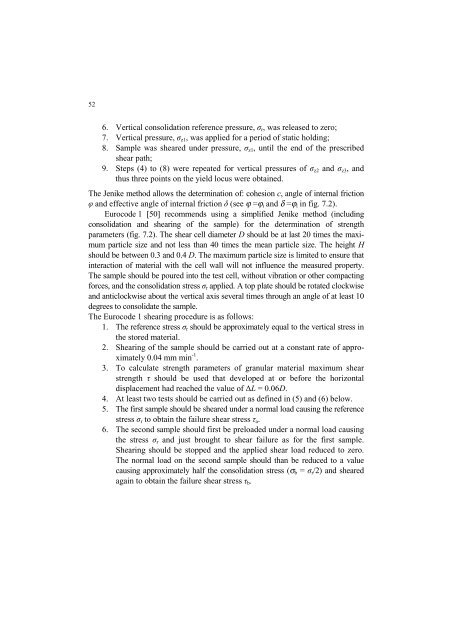Strona 2_redak - Instytut Agrofizyki im. Bohdana DobrzaÅskiego ...
Strona 2_redak - Instytut Agrofizyki im. Bohdana DobrzaÅskiego ...
Strona 2_redak - Instytut Agrofizyki im. Bohdana DobrzaÅskiego ...
Create successful ePaper yourself
Turn your PDF publications into a flip-book with our unique Google optimized e-Paper software.
52<br />
6. Vertical consolidation reference pressure, σ r , was released to zero;<br />
7. Vertical pressure, σ z1 , was applied for a period of static holding;<br />
8. Sample was sheared under pressure, σ z1 , until the end of the prescribed<br />
shear path;<br />
9. Steps (4) to (8) were repeated for vertical pressures of σ z2 and σ z3 , and<br />
thus three points on the yield locus were obtained.<br />
The Jenike method allows the determination of: cohesion c, angle of internal friction<br />
φ and effective angle of internal friction δ (see ϕ =ϕ i and δ =ϕ l in fig. 7.2).<br />
Eurocode 1 [50] recommends using a s<strong>im</strong>plified Jenike method (including<br />
consolidation and shearing of the sample) for the determination of strength<br />
parameters (fig. 7.2). The shear cell diameter D should be at last 20 t<strong>im</strong>es the max<strong>im</strong>um<br />
particle size and not less than 40 t<strong>im</strong>es the mean particle size. The height H<br />
should be between 0.3 and 0.4 D. The max<strong>im</strong>um particle size is l<strong>im</strong>ited to ensure that<br />
interaction of material with the cell wall will not influence the measured property.<br />
The sample should be poured into the test cell, without vibration or other compacting<br />
forces, and the consolidation stress σ r applied. A top plate should be rotated clockwise<br />
and anticlockwise about the vertical axis several t<strong>im</strong>es through an angle of at least 10<br />
degrees to consolidate the sample.<br />
The Eurocode 1 shearing procedure is as follows:<br />
1. The reference stress σ r should be approx<strong>im</strong>ately equal to the vertical stress in<br />
the stored material.<br />
2. Shearing of the sample should be carried out at a constant rate of approx<strong>im</strong>ately<br />
0.04 mm min -1 .<br />
3. To calculate strength parameters of granular material max<strong>im</strong>um shear<br />
strength τ should be used that developed at or before the horizontal<br />
displacement had reached the value of ∆L = 0.06D.<br />
4. At least two tests should be carried out as defined in (5) and (6) below.<br />
5. The first sample should be sheared under a normal load causing the reference<br />
stress σ r to obtain the failure shear stress τ a .<br />
6. The second sample should first be preloaded under a normal load causing<br />
the stress σ r and just brought to shear failure as for the first sample.<br />
Shearing should be stopped and the applied shear load reduced to zero.<br />
The normal load on the second sample should than be reduced to a value<br />
causing approx<strong>im</strong>ately half the consolidation stress (σ b = σ r /2) and sheared<br />
again to obtain the failure shear stress τ b .
















